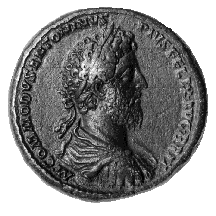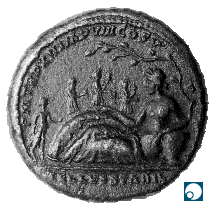



(107) Commodus - AE medallion, c. A.D. 187, 57.43 g. (inv. 91.188).
Obverse: Laureate and cuirassed bust of Commodus r.; M(ARCVS)
COMMODVS ANTONINVS PIVS FELIX AVG(VSTVS) BRIT(ANNICVS): Marcus Commodus
Antoninus Pius, fortunate Augustus, restorer of Britain.
Reverse: Tellus reclining l. with starred globe on r. and
fruit basket at l.; the Four Seasons march over the globe; in exergue, TELLVS
STABIL(ITA): Mother Earth made steady; P(ONTIFEX) M(AXIMVS) TR(IBVNICIA)
P(OTESTATE) XII IMP(ERATOR) VIII CO(N)S(VL) V P(ATER) P(ATRIAE): Pontifex
maximus, with tribunician power for the twelfth time, imperator
for the eighth time, consul for the fifth time, father of the country.
Provenance: Bank Leu, 1983.
Bibliography: J.P.C. Kent, Roman Coins (London 1978)
no. 359.
Marcus Aurelius' son Commodus was born in A.D. 161. He held the title Caesar
from A.D. 166 until A.D. 177, when he became co-emperor with Aurelius. Commodus
acceded to the throne as sole emperor at Marcus Aurelius' death in A.D.
180. Commodus' reign was largely peaceful, but trouble occurred with the
violation of the Antonine Wall in Britain, and Commodus gained the title
Britannicus upon the victory in Britain of A.D. 184. The title felix,
also from A.D. 184, refers to the success in Britain and perhaps as well
to military success in Sarmatia. Commodus was contemptuous of the Senate,
increasingly autocratic, and in the end mad, associating himself with numerous
divinities and especially with Hercules, engaging in gladiatorial games
and renaming Rome Colonia Commodiana. He was assassinated in A.D. 192.
The obverse portrait belongs to the type of Commodus' later portraits; he
is in his late twenties and has a full and detailed beard. The reverse depicts
Tellus (Mother Earth); since she has been "stabilized," this image
can be viewed as sending the perhaps much-needed message that foreign affairs
are in the emperor's allegedly capable hands.
Many medallions such as this were minted during the Roman imperial period.
They differ in size and weight from ordinary coinage. Other than the fact
that they are typically commemorative, their function remains somewhat obscure;
it is clear, however, that they were not financial instruments in general
circulation. A greater variety of mythological scenes is illustrated on
medallions than on ordinary coinage, and the medallion seems to occupy a
niche as a showcase for especially detailed artistic depiction and excellent
craftsmanship.
M.D.P.



All contents copyright (c) 1996.
Lawrence University
All rights reserved.